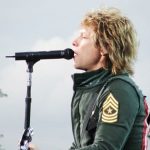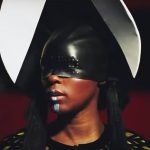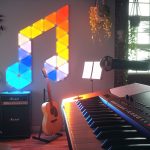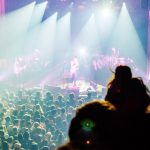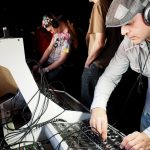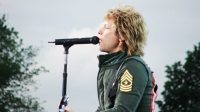Behind The Scenes Of Björk’s Insane, Immersive Room-Sized Music Video
How the team behind Björk’s Black Lake film at MoMA designed a music video befitting a museum.
The first time I see Björk’s epic new 10-minute music video, something unusual is happening: Björk is there. It’s hard to see her in the near-total darkness—not to mention the full-body cactus costume she’s wearing—but the renowned musician has come to greet the crowd at New York’s Museum of Modern Art for this special occasion: the opening of a retrospective exhibit charting her career.
One of the central components of the exhibit is a video for Black Lake, an immersive multimedia experience specially designed by Björk in collaboration with MoMA, architecture firm The Living, and its new parent company, Autodesk. Upon stepping into the black standing-room-only space in which the video is screened, you would never know the complexity of the process that produced not just the film, but the very room in which it lives.
“It was a film production company, a record label, a museum, and an architect all coming together,” says Andrew Thomas Huang, who directed the video. “It was pretty insane.”
For nearly a year, Huang collaborated with Björk, MoMA curator Klaus Biesenbach, The Living founder David Benjamin, and Autodesk’s director of emerging technology, Brian Pene, to create the Black Lake experience. “The museum was not built for great acoustics,” says Huang. “She wanted to build a dome that created a sound vacuum.”
After countless iterations, the final product opened it doors on March 2: a small standing-room theater adorned with two large screens on either side of the room, each one simultaneously displaying different angles and scenes of the same video. The ceiling is affixed with strategically placed speakers that carry the song throughout the room. What isn’t obvious is the room’s most interesting feature: The design of its walls and ceiling is based on the song itself.
As Huang continued to work on the video production, Benjamin and his team at The Living set out to design the room. Using open-source audio-editing software, Benjamin produced a visual analysis of the “Black Lake” song, mapping its volume and octaves into a colorful, psychedelic-looking waveform. That pattern was then mapped to a blueprint of the room’s ceiling and walls using Autodesk’s software, with each inch of the room representing one second of the song. “I feel like there’s something poetic about the fact that this is made from her music and it’s also absorbing that sound,” says Huang.
Just as the waveform has peaks and valleys, the room’s interior itself has a sort of topography: Black felt cones of varying heights line the walls and ceilings, taking on the shape of the song without attendees even realizing it. Those cones were designed—and frequently redesigned—by Benjamin and his team, at times with the aid of 3-D modeling software. “One of the interesting things for me was to think about how the architecture could support the sound,” says Benjamin. “It was actually a very specific choice how much we varied the height and size of the cones in order to break up and deaden the sound.”
Long before construction of the mini-theater was finished, Benjamin’s team created a three-dimensional digital model of it for the Oculus Rift and used the headset to virtually walk through the room. “We think that’s a really interesting possibility for design,” says Benjamin. “We were lucky that we could use software where you can just dial up and down the height of the cones or make them move around a point where a speaker has to mount to the ceiling. If we had to draw that stuff by hand, then every time a speaker changed, we’d have to start over. It would have taken like 40 hours.”
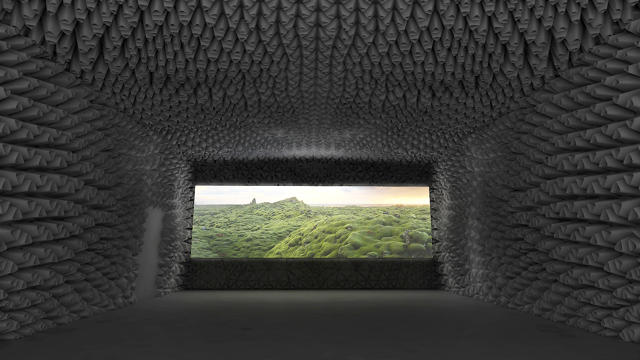
It wasn’t entirely intentional, but these black, knob-like cones mimic the landscape of the video itself, which was shot in a black ravine carved by a glacier in Iceland. “We wanted it to feel cave-like,” says Huang. “It succeeded in feeling like that.”
The production of the video required its own share of bleeding-edge technology. Much of its expansive landscape was generated from high-resolution photogrammetry shot by drones flying over the shooting site in Iceland. Much of the strange, wound-like body suit worn by Björk in the video was designed in house at Autodesk—with input from Huang, who requested that a specific Icelandic fungus be incorporated into the design—and then 3-D printed and shipped to Huang and his team. Some of the 3-D scans even wound up on the recently unveiled cover of Björk’s upcoming album.

While the team behind Black Lake seemed satisfied on Monday afternoon, the process wasn’t without its logistical challenges. Despite the big names involved, budget was one of them. “It’s still the arts,” notes Huang.
On top of that, seemingly every other design choice had to be checked against architectural feasibility, acoustic priorities, and even the union regulations that govern the MoMA building. “Honestly, it was like, how do we create Björk: The Disneyland Ride?” jokes Huang. “It was a physical implementation. You have to think about traffic flow, how many people can fit in the room, how long they’re going to be in that room. Some of them weren’t made until last week. Is there going to be enough oxygen in there?”
There was plenty.
Black Lake, along with the rest of the Björk retrospective exhibit, is on display at New York’s MoMA from now until June 7, 2015.
[Animations & Photos: courtesy of Wolf & Crow + Andrew Huang, Autodesk, Ray Wang, The Living, and xRez Studios]
Fast Company , Read Full Story
(277)


